Stone countertops in the bathroom: varieties, selection, care

Stone countertops are a great way not only to decorate a bathroom, but also to rationally organize its space. A wide variety of materials from which these interior elements are made makes it possible to realize almost any designer's idea. We will tell you about the main types of stone countertops, their characteristics, give examples of successful design solutions, and give advice on choosing.
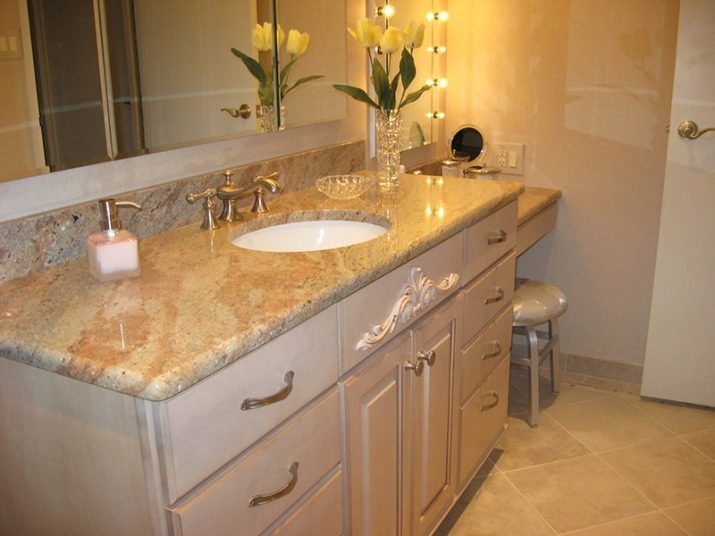
Views
All stone countertops are divided into two types according to the type of material:
- from natural stone;
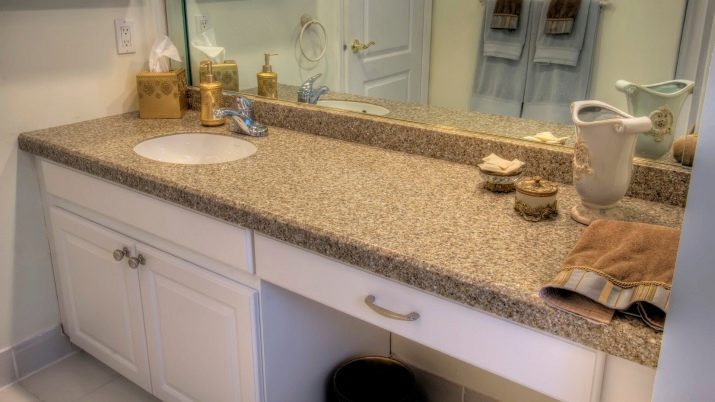
- made of artificial.
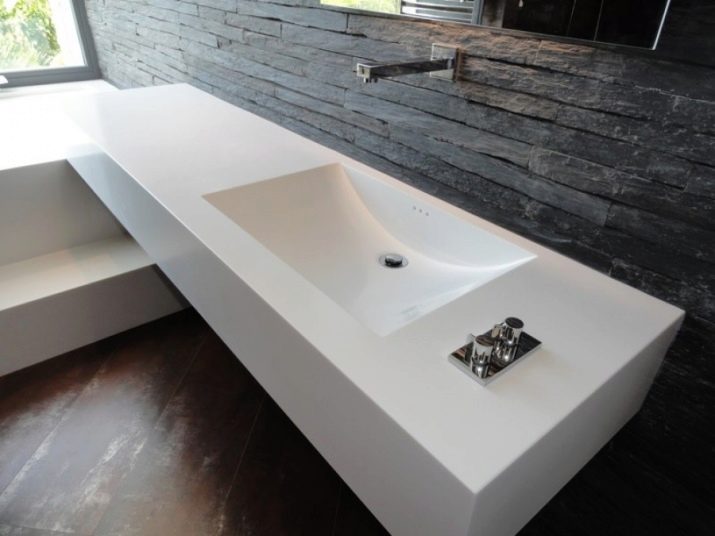
Natural stone from which countertops are made in the bathroom is:
- marble;

- granite;

- travertine;
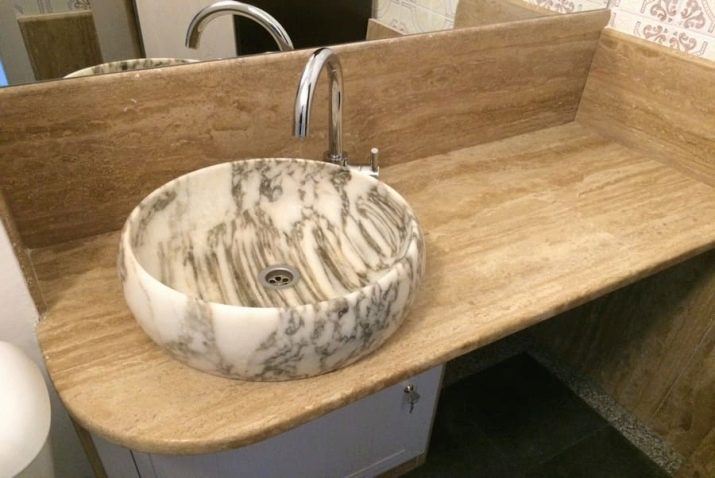
- onyx.
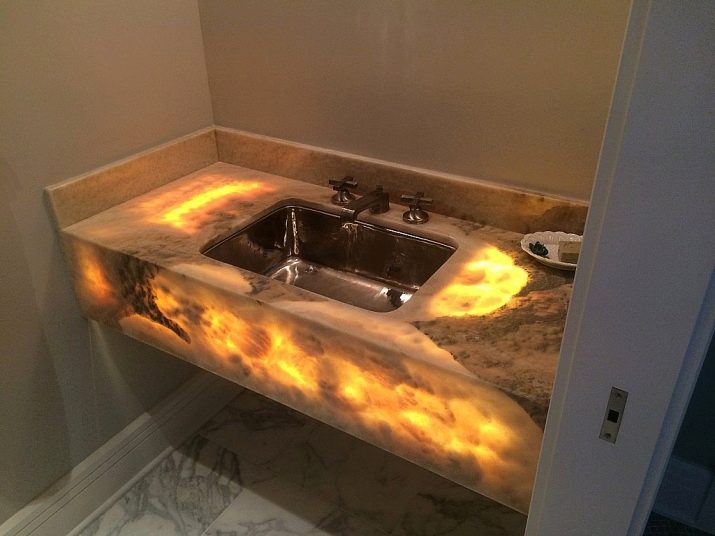
The artificial stone used for the manufacture of countertops can also be of different types:
- artificial marble;
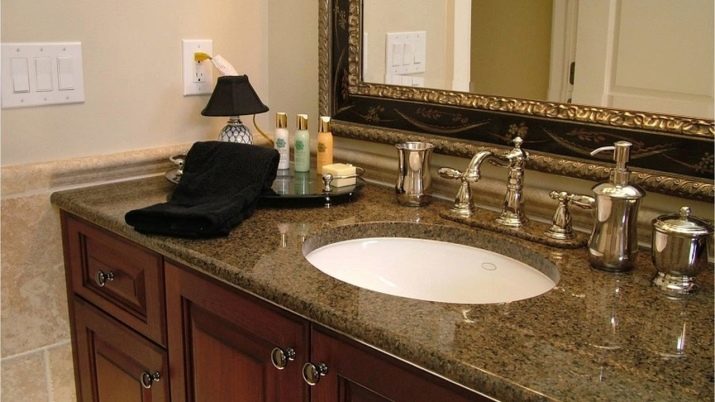
- quartz agglomerate;
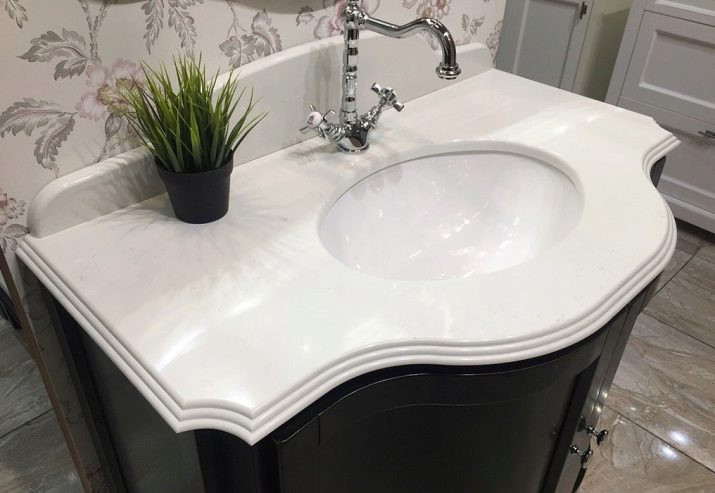
- acrylic stone.
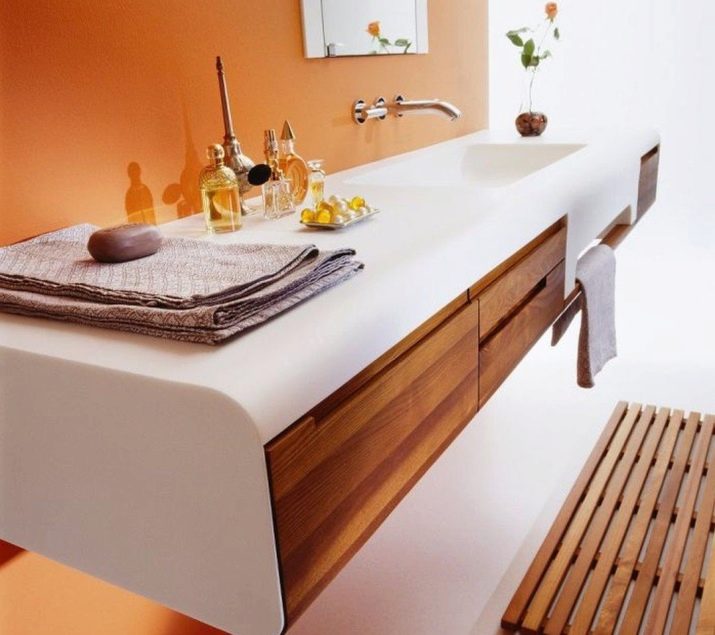
Artificial stone countertops can be made in a wide variety of sizes and shapes, including with an integrated sink... A design option, when the sink and countertop are a monolithic product, are offered by many manufacturers, and such a thing looks very impressive. Acrylic stone countertops are distinguished by the widest variety of colors and shapes.
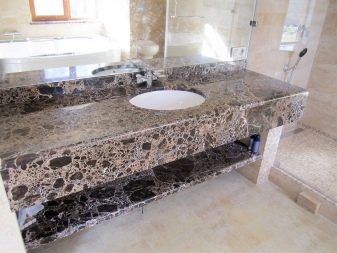
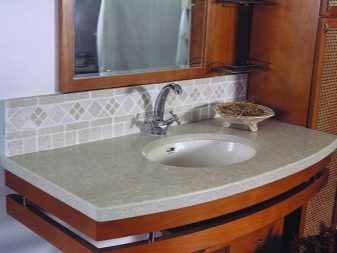
Advantages and disadvantages
Speaking about the pros and cons of purchasing and using a stone countertop, one should first of all build on the properties of the material from which it is made. Products made from natural materials differ in their qualities and properties from those made from artificial stone.
Natural stone countertops are expensive.In this case, the properties of the product depend on the type of natural material used to make the countertop.
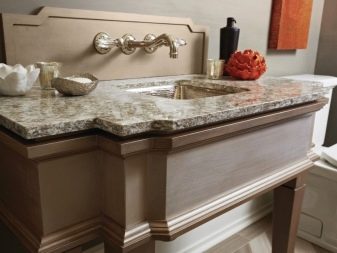
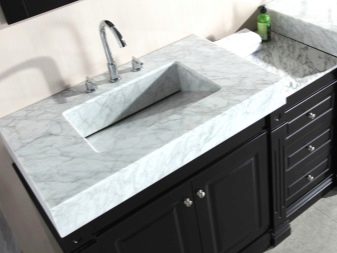
Marble has a unique beautiful pattern, a wide selection of shades suitable for different interiors. By polishing, you can achieve a smooth shiny surface, which looks very impressive. As well as polishing, you can remove minor scratches resulting from the use of the countertop.

However, this natural material has a number of disadvantages that must be taken into account when making a purchase decision:
- the surface must be protected from the effects of oils and substances containing dyes, as stains may appear on it, since the marble has a porous structure;
- Do not drop heavy objects on the countertop - this can lead to scratches and chips, because the material is not very durable;
- it is not necessary to allow acids to get on the marble - this will ruin it, the use of abrasive cleaning agents is also prohibited;
- do not put hot objects on the marble surface;
- this natural stone is always cold to the touch.
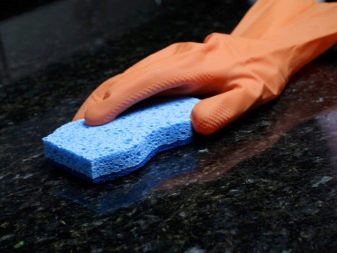

Countertops from onyx and travertine have advantages and disadvantages similar to marble: this is an original natural pattern, sufficient moisture resistance, durability, but instability to the effects of acids and abrasives, the formation of chips and scratches as a result of impacts on the surface. Onyx is significantly more expensive than marble or travertine; although it is a more fragile stone, it is valued for its high decorative qualities; products made from it look very impressive, especially if they are equipped with backlighting.
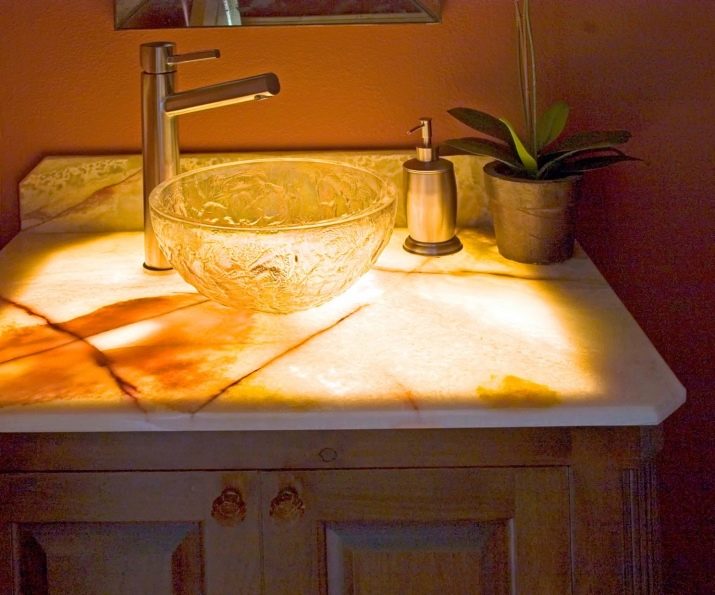
Granite - This is an expensive natural material that is used to make stone countertops for the bathroom. Like marble, granite is distinguished by a wide palette of different shades and unique patterns created by nature itself. This is a very durable stone, products made from it are durable and resistant to mechanical stress, you can not be afraid of scratches and chips during operation.
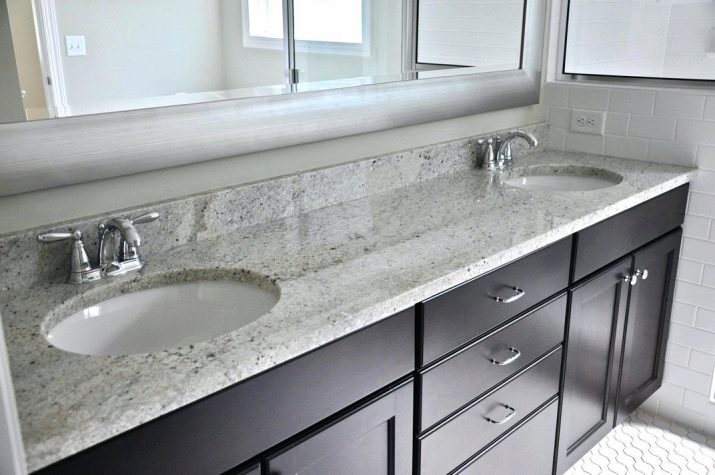
However, granite is also not devoid of disadvantages, which include:
- significant weight - this is one of the heaviest materials used for the manufacture of countertops;
- discoloration of the surface, the appearance of spots on it as a result of contact with dyes, oils, acids.
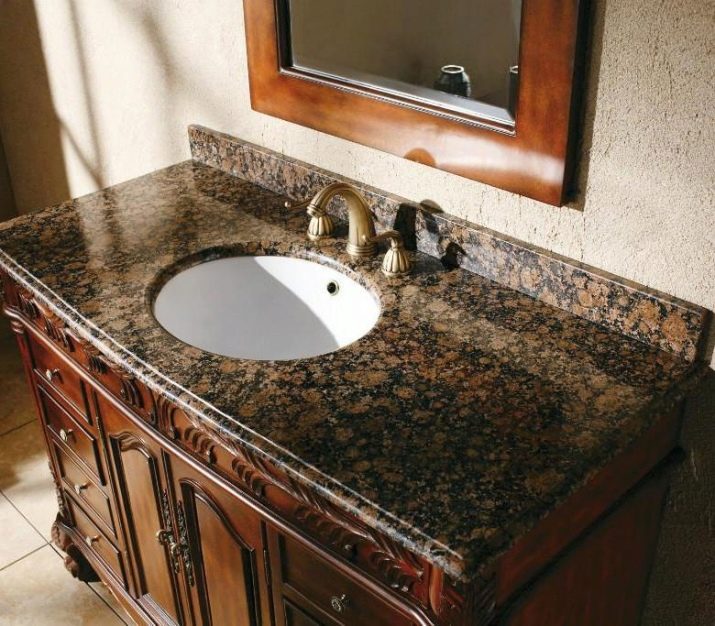
It is worth considering separately artificial marble and quartz agglomerate, their advantages and disadvantages.
When creating artificial marble, a filler made of marble chips and polyester resins are used as a binder; in the manufacture of quartz agglomerate, quartz chips are used as a filler. Countertops made of reconstituted marble and quartz agglomerate have a number of advantages over natural stone products:
- presented in a wide range of colors, including those created in shades unusual for natural materials or very rare;
- non-staining, resistant to oils and dyes due to the lack of porosity;
- are characterized by high hygiene, since they do not have small voids into which water and microbes would get;
- more durable, so you can not be afraid of the appearance of chips, and also order a thinner countertop;
- are made in any configurations, for example, there are models in which the sink and countertop are a single product;
- have a lower cost.
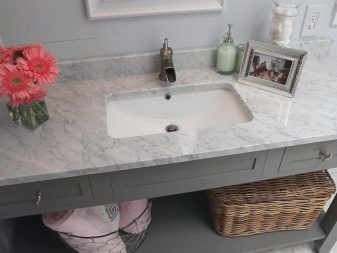
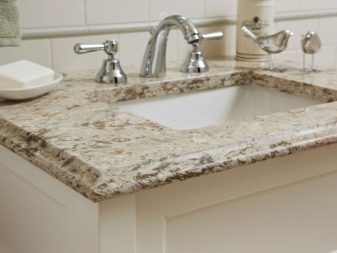
notice, that artificial marble is 2 times lighter than natural marble, which simplifies the delivery and installation of the product. But the countertops made of quartz agglomerate are heavy, and their disadvantage can also be considered the visibility of the joints, in those cases when they are mounted from several parts. However, a long service life (such products are almost eternal, according to some manufacturers), moisture and heat resistance make quartz agglomerate a popular material for the manufacture of bathroom countertops.

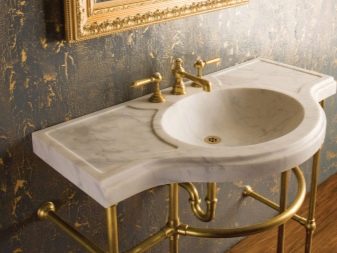
Acrylic stone countertops have a number of advantages that make them well suited for bathrooms, namely:
- water resistance and high hygiene, since the material is non-porous;
- a wide variety of colors, shades, imitations of various textures;
- maximum selection of various shapes (including with an integrated sink) and design options;
- high strength;
- easily cleaned of dirt,
- maintainability, scratches on the surface are eliminated by grinding, dismantling is not required;
- harmlessness to humans.
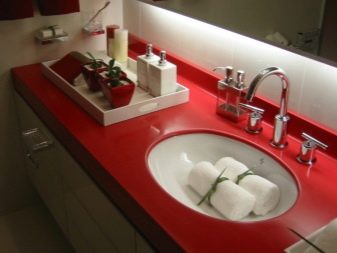
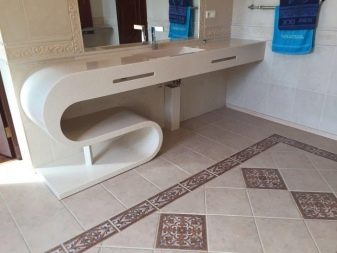
Has an acrylic stone and disadvantages that must be taken into account when using the countertop:
- low heat resistance, do not put hot objects on it, pour boiling water into integrated acrylic stone sinks;
- the surface is easily scratched, so you do not need to use abrasive cleaners;
- it should be protected from the effects of aggressive acids, dyes and acetone.
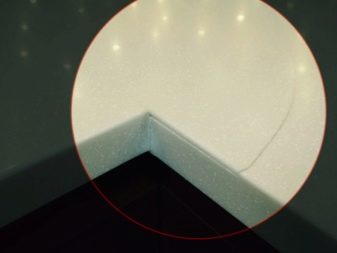
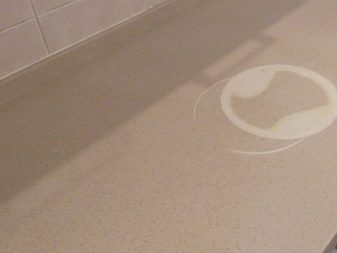
Shapes and sizes
The standard thickness of acrylic stone countertops is 30-40 mm. Moreover, in some versions, the thickness of the stone itself is only 12 mm, the rest is a substrate made of moisture-resistant material. For the bathroom, monolithic countertops are recommended, without an inner base of plywood, chipboard or other material. Only in this case can they be installed in a damp room without fear that the product will deteriorate.
Monolithic acrylic stone has a long service life and can be repaired if necessary.

Countertops made of acrylic artificial stone are made of any shape and size, this material is considered universal. Its properties make it possible to manufacture worktops of any design without visible seams.
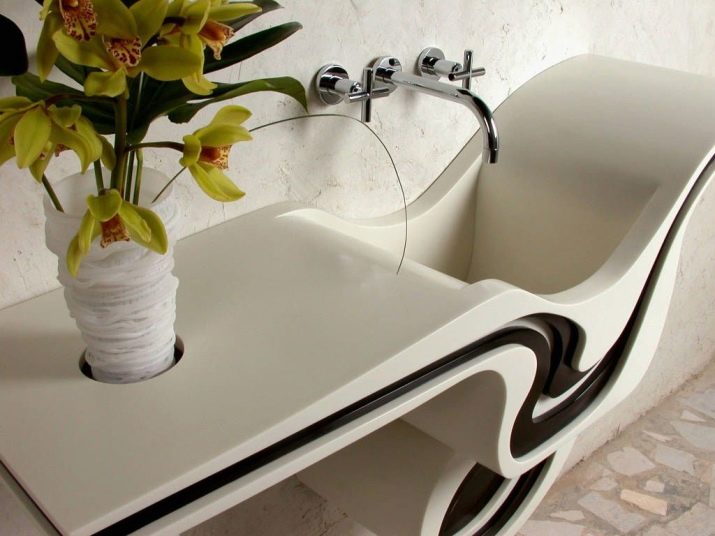
The thickness of the worktops made of quartz agglomerate can be 12, 20 or 30 mm, of cast marble - 30 mm.

The most common forms are:
- rectangular;
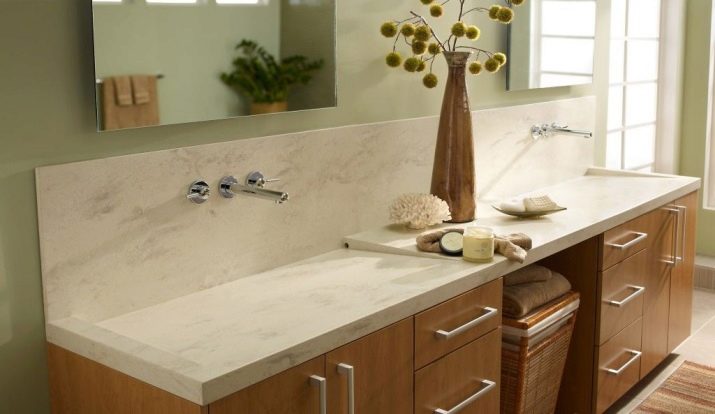
- L-shaped;
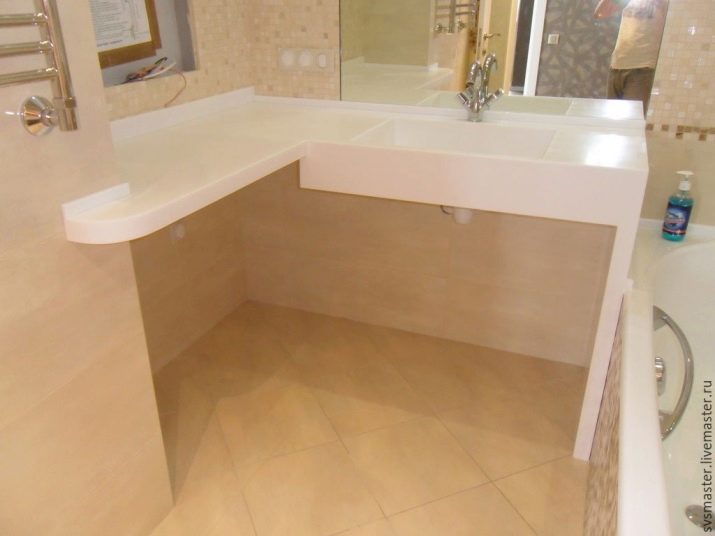
- U-shaped.
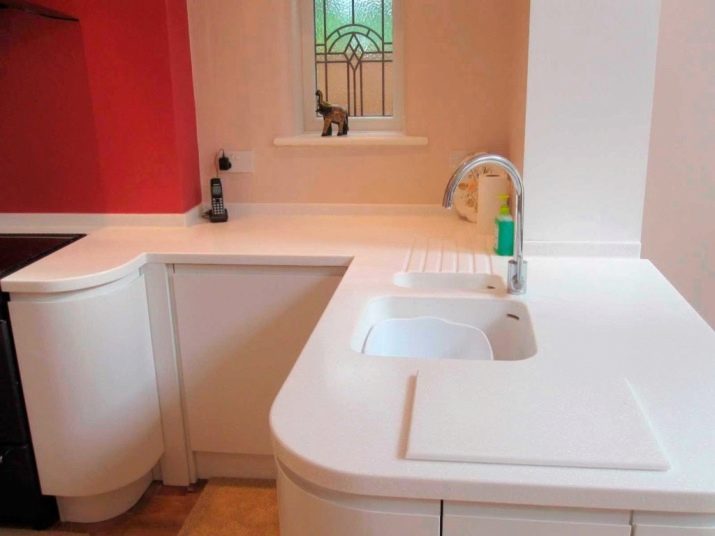
Design
Artificial stone countertops can be presented in a wide variety of designs. By the type of location in the bathroom space, they are:
- hinged;
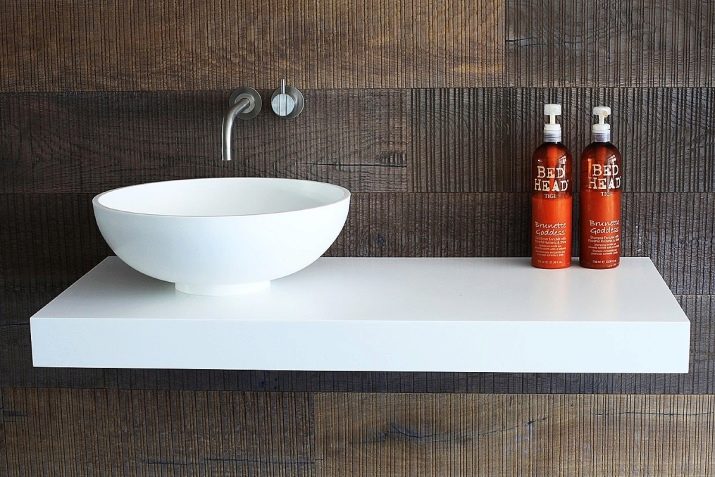
- waybills.
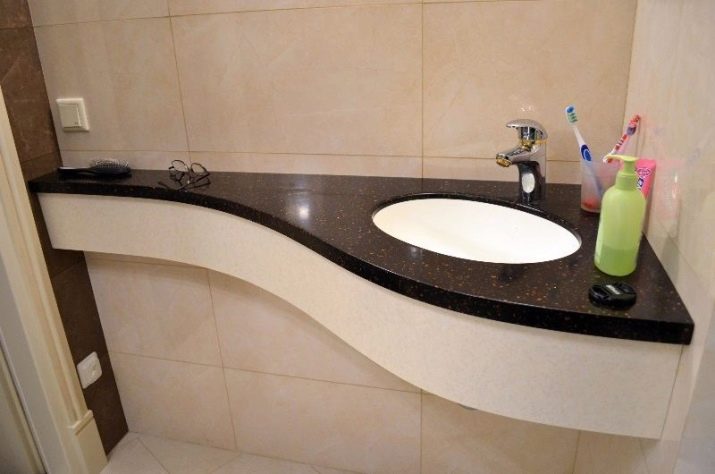
In the first case, the tabletop is attached to the wall, in the second, it covers a curbstone, chest of drawers or a small shelving unit.
By the type of sink location, the following design options are found:
- with an integrated (monolithic) sink;
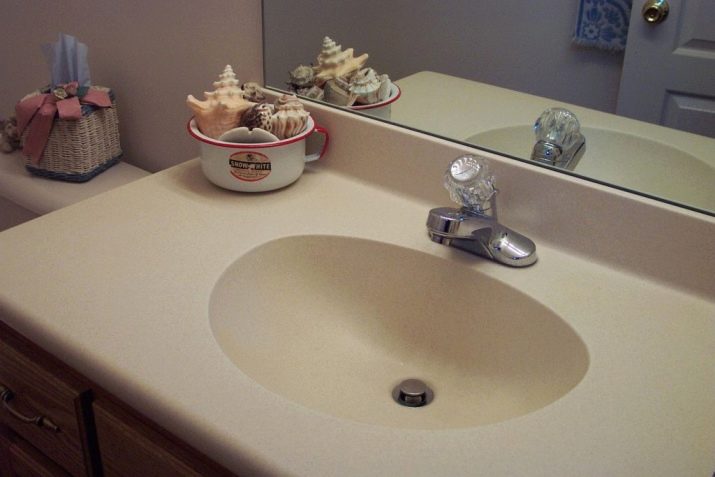
- with mortise;
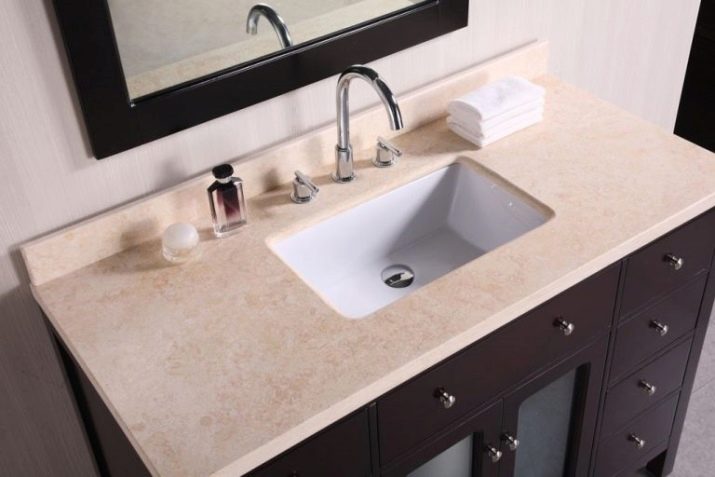
- with a sink on the countertop.
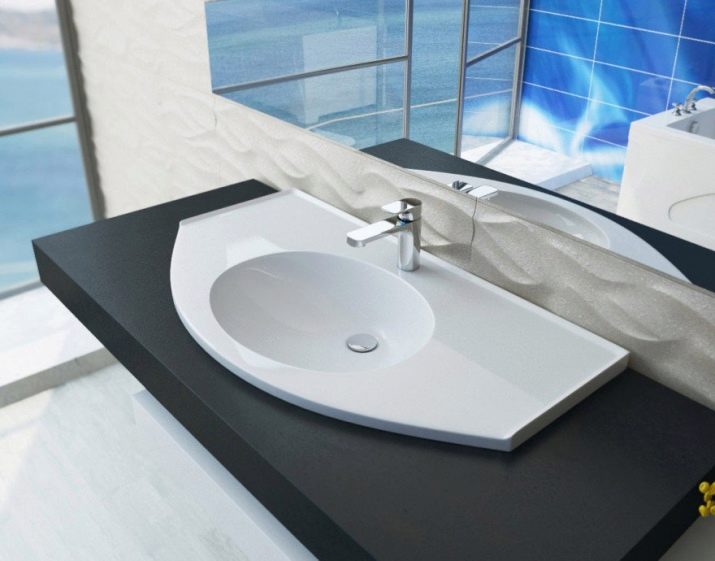
The shape of the integrated shells can be absolutely any: oval, circle, square, more complex configurations.
According to color schemes, countertops with sinks are:
- with a sink in the color of the countertop;
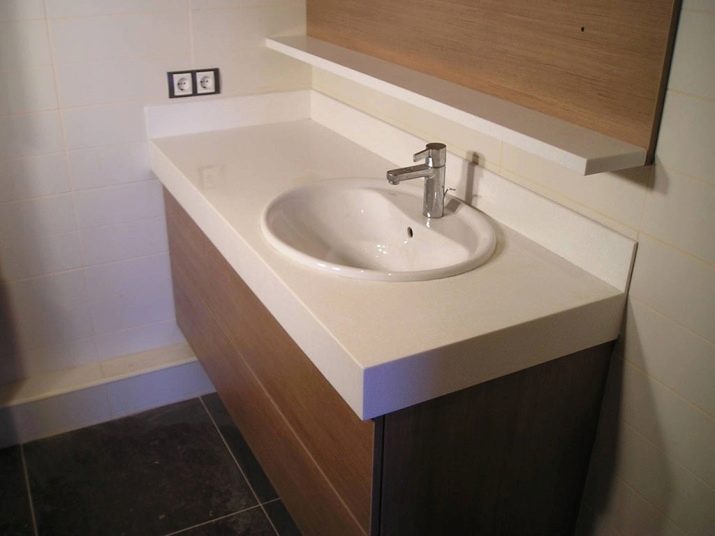
- with washbasin in contrasting color.
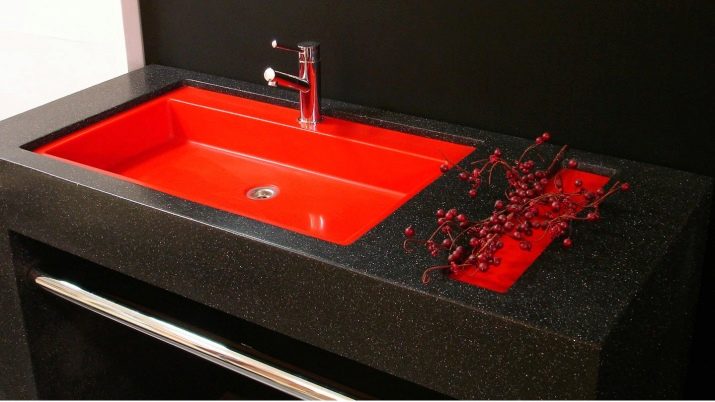
By the number of sinks:
- with one;
- With several;
- no shells.
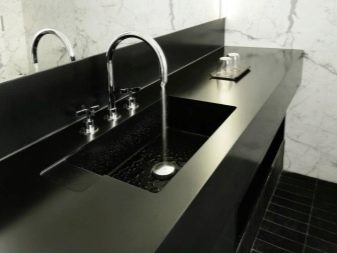
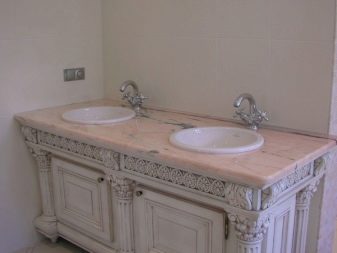
And also countertops can be:
- single-level or multi-level;
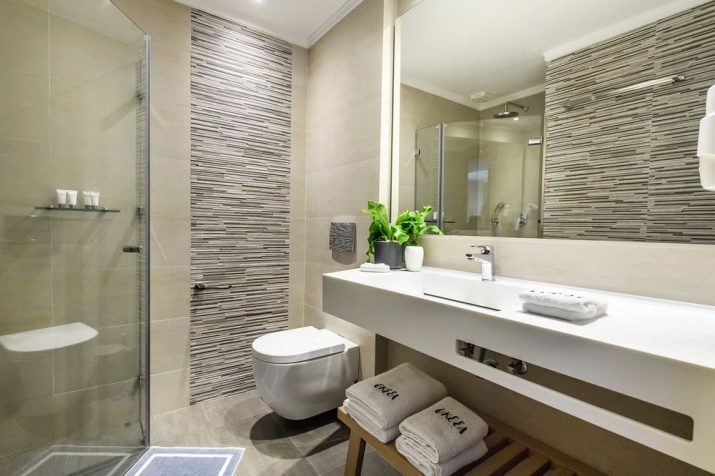
- simple or complex shape;
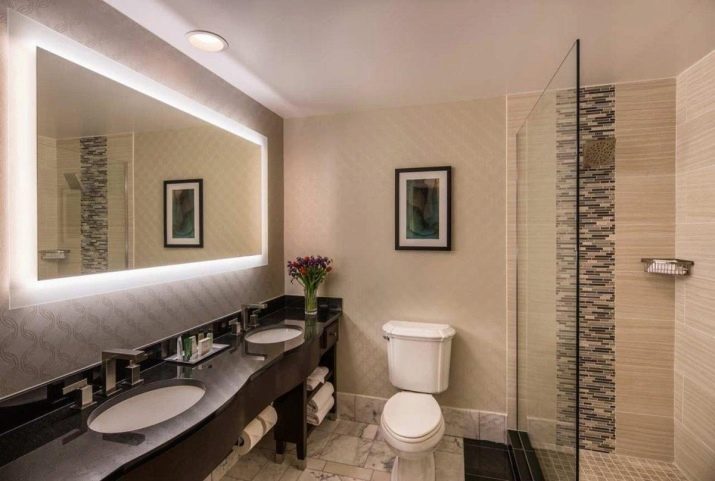
- corner, or located along one wall of the room.
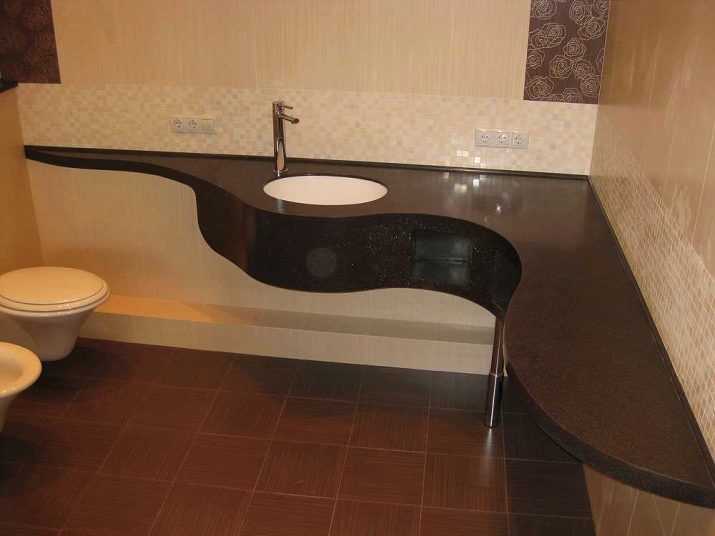
How to choose?
Countertops made of artificial or natural stone for a room with high humidity, such as a bathroom, are the ideal solution. In order to choose the best option for each specific case, you need to take into account the properties of a certain material and the habits of people using the room and countertop.
If you intend to frequently use appliances with heating elements, such as curling irons, then it is better to choose a heat-resistant surface made of quartz agglomerate, artificial marble or natural granite, since acrylic stone deteriorates under the influence of high temperatures.
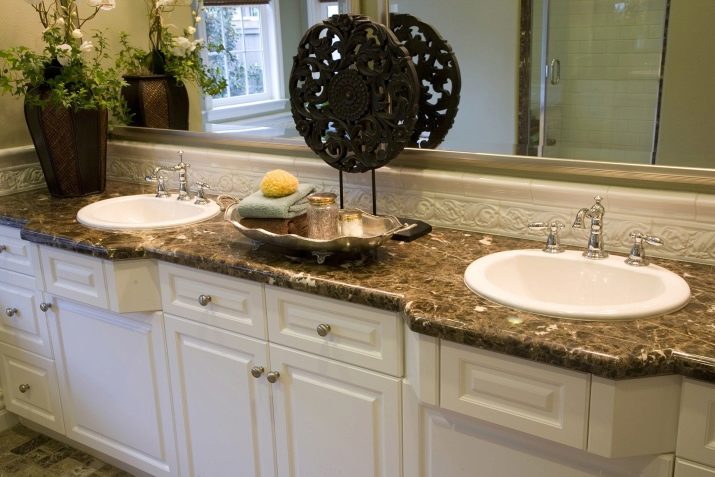
If at the sketching stage it becomes clear that a product of a complex, fancy shape is required, then the choice should be stopped on acrylic stone or cast marble, from which a tabletop of any configuration can be made. But since the acrylic stone surface is easily scratched, it is better to prefer light colors, on which such defects, if they appear, will be less noticeable... In addition, light surfaces are more suitable for small rooms, since they allow you to visually expand it.

On matte surfaces, traces of dried water drops are less visible, on glossy surfaces, on the contrary.
Products made of granite or quartz agglomerate are heavy, so they need to be installed on reliable and strong supports, which should be taken into account when working on the design of the countertop. But these surfaces are not afraid of scratches and have an almost unlimited service life.
If it is important that the finished countertop has no joints on the surface, even with a long length, then you should pay attention to acrylic stone or cast marble, products from which are obtained "seamless".
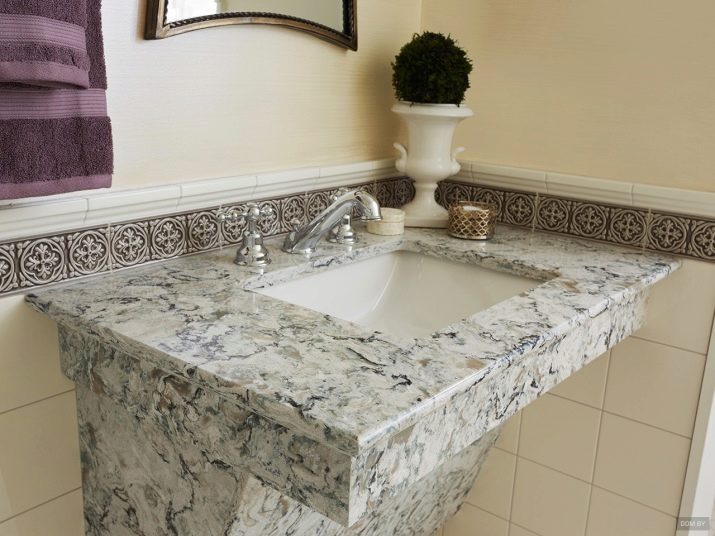
How to care?
Stone countertops made from natural marble, onyx and travertine require special care. In order to avoid the appearance of spots on their surface, it is necessary to use special protective impregnations that close the pores of the stone from the ingress of various liquids into them. It is not recommended to place cosmetics and perfumes directly on the stone surface - it is better to use trays or napkins.
If scratches appear on the countertop, you should contact a specialist who will return it to its original condition, grind and polish if necessary.
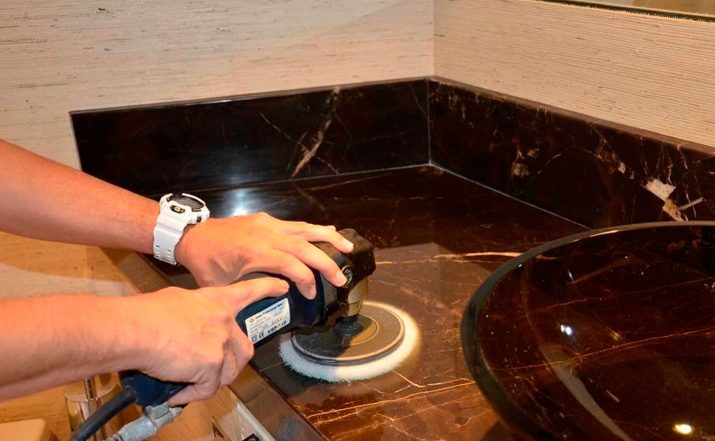
Articles made of artificial (cast) marble do not need special protection, since the material is non-porous, and the formation of spots on the surface is excluded. Artificial and natural marble, acrylic stone should be protected from acids, the use of abrasive cleaning agents should also be abandoned.
Artificial stone countertops do not require special care, it will be enough to wipe them with a soft damp cloth: any contamination from such surfaces, due to their non-porosity, can be easily removed. If necessary, soapy water can be used during washing.
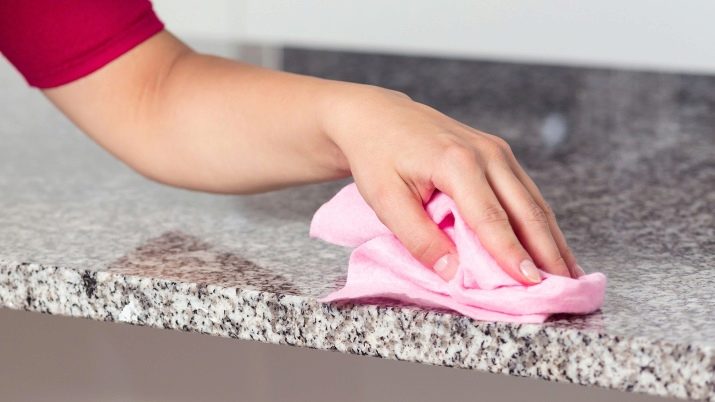
Beautiful examples in the interior
Modern technologies make it possible to produce countertops of various shapes and colors from artificial stone, which makes it possible to make them part of a single ensemble with furniture installed in the bathroom.
If there is a washing machine in the room, then the tabletop allows you to effectively use the space above its body, covering it with a stone surface. Often, the washing machine is installed next to the washbasin, which is integrated into the countertop.
This option with a washing machine under the countertop is very practical.
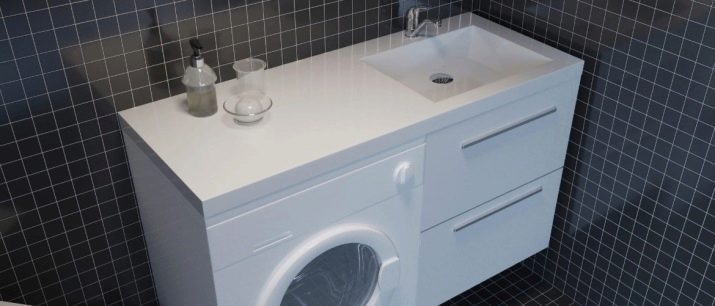
The surfaces in which the sinks of the same color and texture are integrated look very impressive. In some cases, designers suggest, on the contrary, to make a sink in a contrasting color.
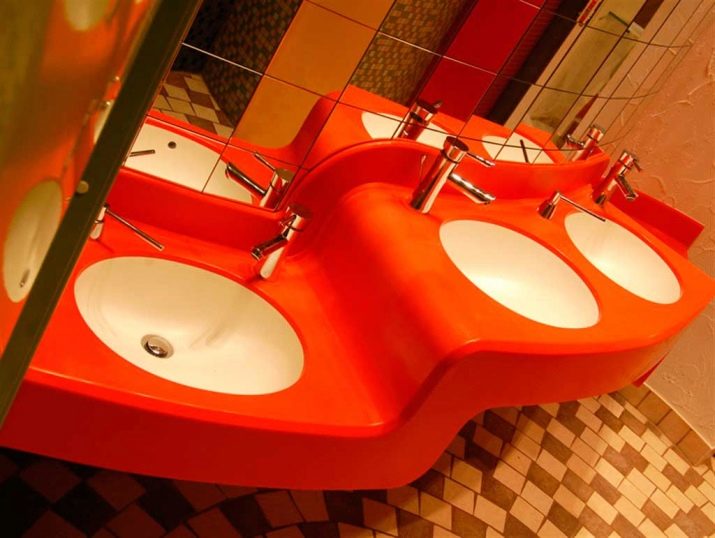
When choosing a color scheme for overhead countertops, the principle of contrast is often used: if the case of a chest of drawers or cabinets, shelves are made in light colors, then dark shades are chosen for the top cover, and vice versa. Items placed on the surface (a dispenser for liquid soap, a soap dish, candlesticks, towels, vases and others) are also selected in a contrasting color: light - dark, dark - light, to match the chest of drawers or the color of the walls of the room.
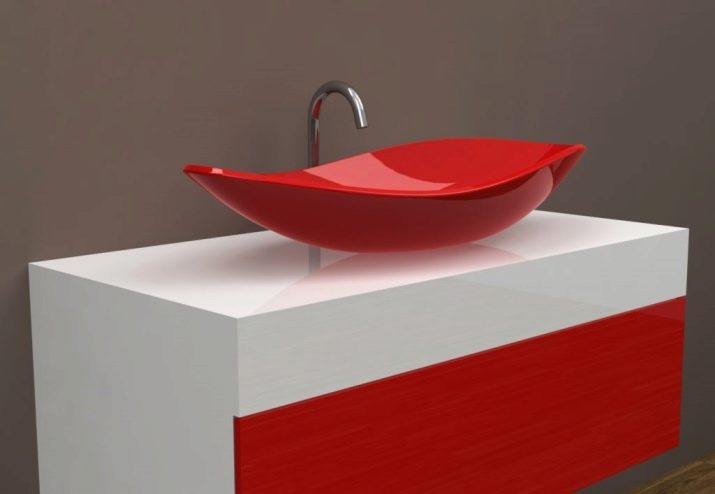
An overhead tabletop in the color of the cabinet body also looks impressive, especially when the feeling is created that the whole structure is a monolith, or if the selected tabletop pattern matches the color of the furniture.
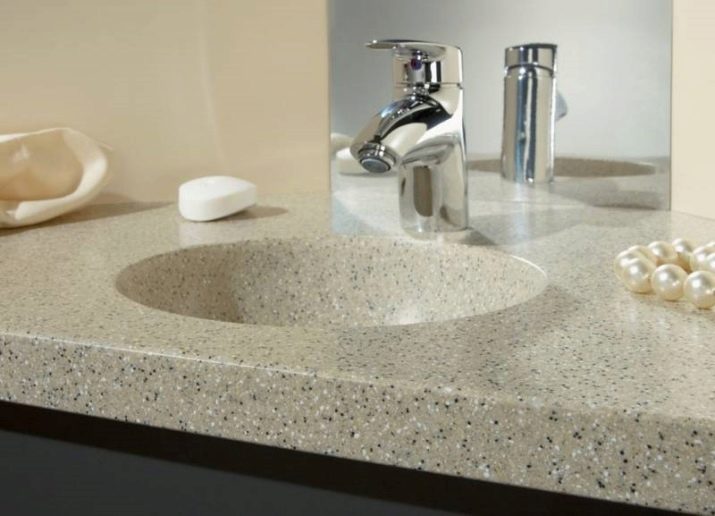
In different interior styles
Rectangular countertops made of solid white or dark stone are chosen for a bathroom in style minimalism. It is well suited for small spaces as it focuses on the functionality of every detail. This style is characterized by hinged countertops.
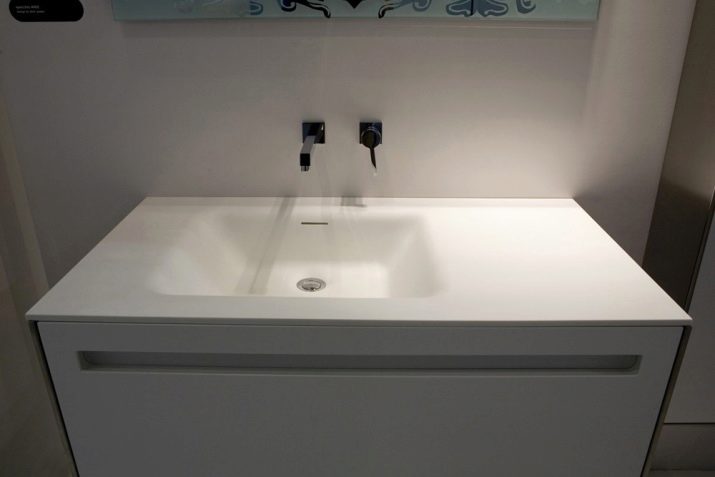
Light shades of natural or artificial marble countertops are used in bathroom interiors decorated in provence style... Here the stone is adjacent to a tree painted with light paint, sometimes artificially aged or brushed, countertops are made overhead, hinged ones are not found. The interior, including the stone surface, is necessarily decorated with fresh flowers in vases, wicker baskets, porcelain jugs, handmade soap and the like.
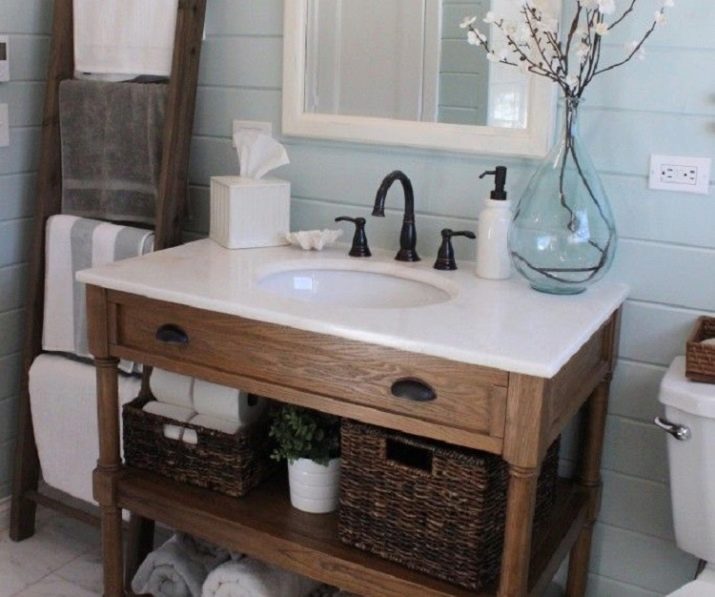
Acrylic stone countertops are used by designers in bathroom interiors country style... In this case, artificial stone is often combined with wood, combining them, for example, in cabinets or other furniture.
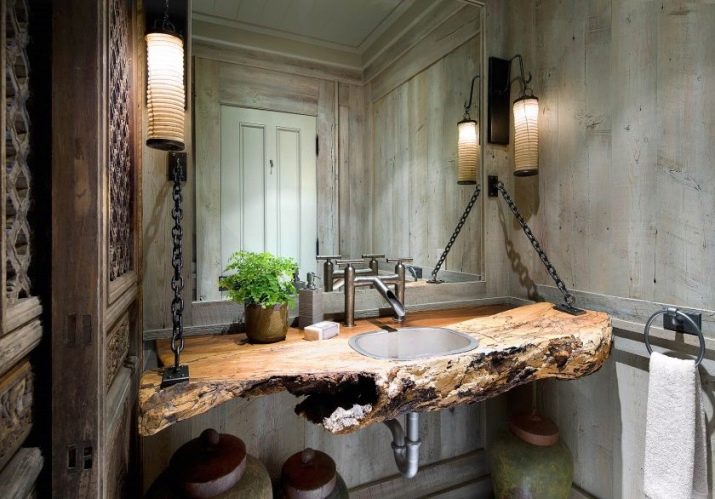
Stone countertops are great for when the bathroom interior is being done in one of the retro styles.
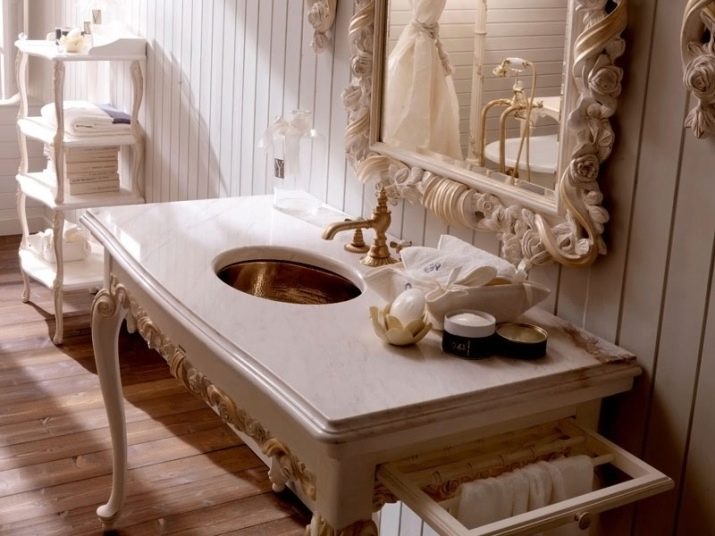
Natural stone countertops - a classic piece of furniture in the Empire style... The beauty and luxury of marble or granite require appropriate framing - precious wood, decorative bronze details.
The interior design of a bathroom in the Empire style is by no means standard, but purchasing a countertop made of natural stone is an extraordinary decision in itself.
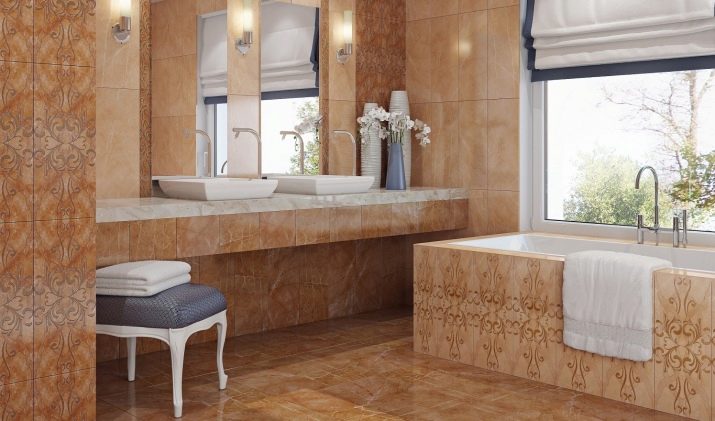
Dark glossy stone countertops contrasting with light base and walls are the perfect element for a style bathroom art deco.
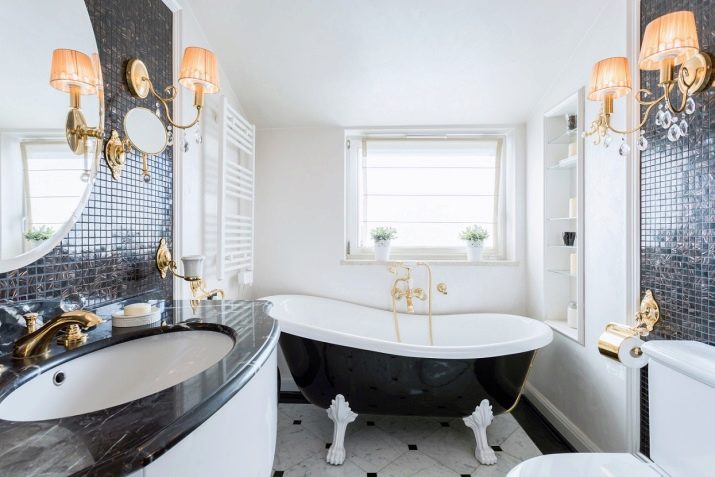
How stone countertops are made, see below.






